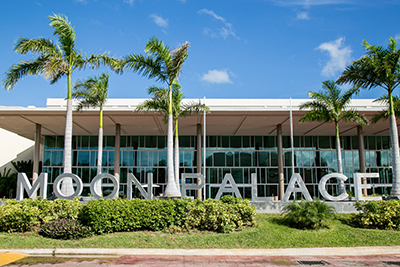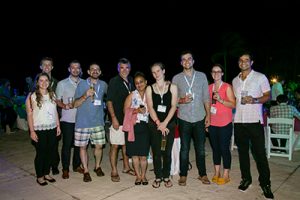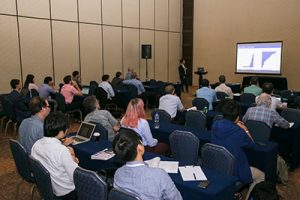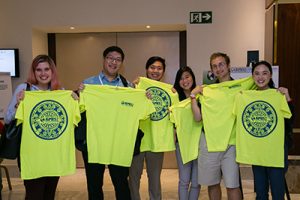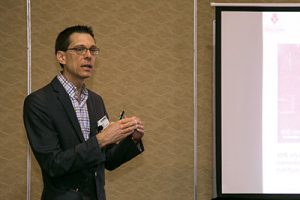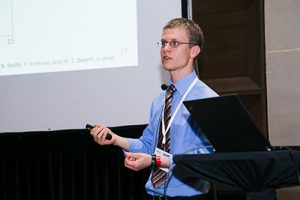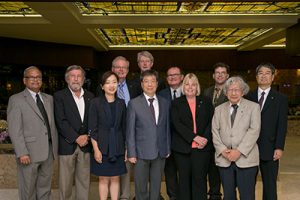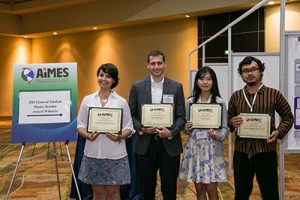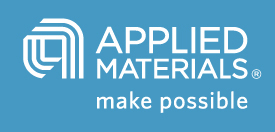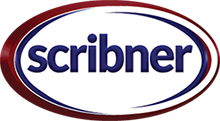Almost 2,000 people attended the Americas International Meeting on Electrochemistry and Solid State Science (AiMES 2018) in Cancun, Mexico, a joint conference of the 234th Meeting of The Electrochemical Society (ECS), the XXXIII Congreso de la Sociedad Mexicana de Electroquímica (SMEQ), and the 11th Meeting of the Mexico Section of The Electrochemical Society, with the technical cosponsorship of the Sociedade Brasileira de Eletroquímica e Eletroanalítica (SBEE), the Sociedad Iberoamericana de Electroquímica (SIBAE), and the Asociación Colombiana de Electroquímica (ACEQ). Participants could choose from 53 symposia, with over 1,700 oral talks and nearly 500 posters, of which almost 600 were student presentations.
Opening Reception
AiMES kicked off with the opening reception on the first night of the meeting. Along the shoreline of the Caribbean Sea, with the sandy beach just steps away, attendees gathered for a night of food, drinks, and great conversation on the Moonlight Terrace of the all-inclusive Moon Palace Resort. People chatted over beers, guacamole and chips, seafood, tacos, and more. Some guests arrived via golf carts, a service offered graciously by the Moon Palace staff.
Dark blue skies and gusts of tropical winds crept in throughout the course of the night, eventually breaking out into a downpour. Although the event was rained out, the party was not. Guests caught back up at a bar inside the hotel, ushering in the week with optimism and laughs.
Plenary Session
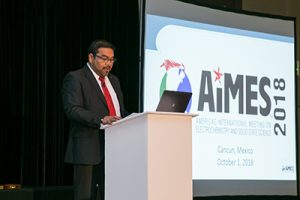
SMEQ President Ricardo Orozco-Cruz presented the opening remarks at AiMES 2018, calling the meeting to order and welcoming attendees to Cancun.
Ricardo Orozco-Cruz, president of the Sociedad Mexicana de Electroquímica, welcomed attendees to the meeting during Monday evening’s plenary session, which wrapped up the day’s technical sessions, honored award winners, and featured a highly anticipated lecture.
“On behalf of SMEQ and ECS, it is my pleasure to call this meeting to order,” announced Orozco-Cruz. “Welcome to Cancun!”
“With 53 topical symposia, 2,100 abstracts, almost 500 invited talks, and nearly 600 student presentations,” Orozco-Cruz continued, “I’m proud to be part of the first Americas International Meeting on Electrochemistry and Solid State Science. We call it AiMES.”
Orozco-Cruz explained that the joint meeting “formalizes our long-standing collaboration with the goal of enabling our research in the Americas.”
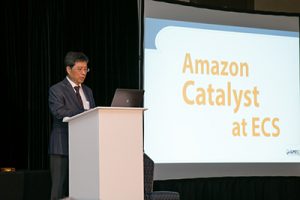
ECS President Yue Kuo recognized the Society’s partners, award winners, and newly inducted fellows during the plenary session.
ECS President Yue Kuo then took the stage, thanking Orozco-Cruz. Kuo acknowledged the success of their partnership, as well as others’ contributions to the Society’s advances.
Kuo thanked past ECS president Johna Leddy and past ECS treasurer E.J. Taylor for their years of distinguished service, which contributed to the continued growth and success of the Society. He also thanked the Society’s institutional members for supporting scientific education, sustainability, and innovation.
“They are truly partners in advancing our science,” said Kuo.
He went on to honor award winners and the Society’s 2018 Class of Fellows.
Kuo ended by emphasizing the importance of International Open Access Week.
“As ECS did the last three years, we are celebrating by giving the world a preview of what complete open access will look like. From October 22 through October 28, we are taking down the paywall to the ECS Digital Library,” said Kuo. “Over 141,000 articles and abstracts will be freely available to anyone who wants to read them. We hope to make this the norm in the future through our Free the Science initiative.”
Plenary Lecture
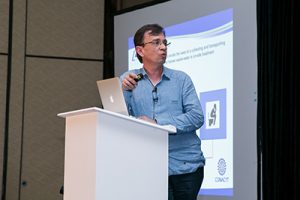
Luis A. Godinez, a researcher at the Centro de Investigacion y Desarrollo Tecnologico en Electroquimica, delivered the meeting’s plenary lecture.
Luis A. Godinez, a researcher at the Centro de Investigación y Desarrollo Tecnológico en Electroquímica, was the meeting’s plenary speaker. His lecture, “Electro- and Photo-Electro-Chemical Generation of the Fenton Reagent. Some Approaches for the Development of Electrochemical Based Advanced Oxidation Processes for Water Treatment,” focused on water management and the technological potential of the electro-Fenton approach—water management being a complicated issue for Mexico.
Godinez described the great need for inexpensive, efficient, and accessible water treatment for disinfection of water for the 2.6 billion people worldwide without access to sanitation services. He described the power of the Fenton reagent (hydrogen peroxide and ferrous ion) to disinfect contaminated water. It is nonspecific (therefore broadly effective) and has a high oxidizing power. The challenges in use at scale are the need for the solution to be acidic and the safety and cost issues surrounding the handling of hydrogen peroxide in large volumes and relevant concentrations. The use of the controlled electrochemical reduction of dissolved oxygen via the two-electron path to produce the hydrogen peroxide needed allows that component to be produced on demand. By adding UV light, photoassistance can be used to create holes, leading to the production of both hydroxyl radicals and regeneration of the ferrous ion (which is oxidized by the peroxide in the process of production of hydroxyl radicals).
Two applications of the electro-Fenton process were described. The first involved the regeneration of activated carbon. This activated carbon is used worldwide as an inexpensive filtration medium, but the standard regeneration processes involve high-energy expenditures and the need to remove the material from the packaging. That standard regeneration process degrades the activated carbon, thus limiting the useful life. Using the electro-Fenton process, the activated carbon can be regenerated in place, and the process is less expensive, and, just as importantly, more gentle to the activated carbon. The process involves three compartments in series, with two of them packed with cation exchange resin. The hydroxyl radicals are produced in situ and react with the pollutants on the activated carbon serving as a cathode. This solution is then passed through the second cation exchange resin which removes the ferric cation (for later regeneration) and the acid (for later neutralization).
The second example involved the creation of a sanitation service for human wastewater using the electro-Fenton process. Godinez showed that the process had excellent inactivation efficiency of Helminth eggs (HE) from the parasite Ascaris lumbicoides. These eggs are difficult to deactivate as they have protective external membranes. For example, the use of hypochlorite solution for two hours reduced the number of HE by only 60%. The electro-Fenton process reduced the number by 92% and altered the shape of the eggs, indicative of permanent damage to the external membranes. Godinez and his team have been able to engineer the reactor in such a way that it can be powered by solar cells.
Electrochemical Energy Summit
The 8th Annual Electrochemical Energy Summit (E2S) was held during AiMES 2018. Its theme was “Sustainable and Responsible Supply of Energy Storage Materials, Components, and Devices.” The summit consisted of invited speakers, posters, and a panel discussion featuring experts along the entire processing chain of energy storage, which includes mining as well as materials, components, and device manufacturing and recycling.
The summit was moderated by Luis A. Diaz Aldana (Idaho National Laboratory) and Marca Doeff (Lawrence Berkeley National Laboratory) and featured the following invited talks:
- “Supply Chain Considerations for Lithium-Ion Battery Materials” by E. A. Olivetti (MIT) and G. Ceder (University of California, Berkeley)
- “Material Criticality and Energy Storage Materials” by R. Eggert (Colorado School of Mines)
- “The Advantages of the Nemaska Electrochemical Process to Directly Synthesize High Purity Lithium Hydroxide” by J. F. Magnan (Nemaska Lithium Inc.)
- “Present Status and Future R&D Needs for Batteries for Vehicle and Grid Applications” by V. Srinivasan (Argonne National Laboratory)
- “Direct Recycling of Lithium-Ion Batteries” by S. E. Sloop (OnTo Technology, LLC), W. Xu (Oregon State University), M. M. Lerner (Oregon State University), J. Kim (Spear Power Systems, LLC), and M. Lee (Spear Power Systems, LLC)
ECS Data Science Showcase
AiMES 2018 featured the first ECS Data Science Showcase, an event that highlighted new electrochemical and solid state research and the open-source software and datasets that underpin the work.
The event was led by the University of Washington team that brought you ECS Data Sciences Hack Day (fall 2017) and ECS Data Sciences Hack Week (spring 2018): Daniel Schwartz, the Boeing-Sutter Professor of Chemical Engineering and director of the Clean Energy Institute at the University of Washington; David Beck, senior data scientist with the eSciences Institute at the University of Washington and associate director of the NSF Data Intensive Research Enabling CleanTech PhD training program; and Matthew Murbach, past president of the ECS University of Washington Student Chapter and advanced data sciences PhD trainee.
Talks were complemented by demonstrations on how others can access, use, modify, and improve the open-source tools and data associated with research projects.
Student Mixer
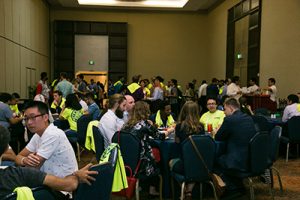
Young researchers mingled while enjoying a buffet of food, desserts, and drinks at the meeting’s student mixer.
Young researchers enjoyed the student mixer held on the second night of AiMES—an event created as a platform for peers and early-career professionals in the field to mix and mingle in a relaxed setting. Guests were greeted with a buffet of food, desserts, and drinks, which they enjoyed as they chatted throughout the night.
Iqra Reyaz Hamdani, from the Indian Institute of Technology Delhi, said that for her, having the opportunity to connect with people from all around the world was a highlight of the event.
Hatem Amin, from the University of Oxford in New York, echoed the same sentiment, saying the student mixer presented the opportunity to meet students he would have never been able to meet at his university or campus alone.
Oliver Rodriguez, from the University of Southampton, said that for him, the mixer was a great way to catch up with students he had met in the past.
All agreed the mixer provided a beneficial platform for young professionals to meet or reunite.
“They’re all my age, so we share a perspective on many things that I may not share with some of the older members of the Society,” said Ian VonWald, from the University of North Carolina at Chapel Hill. “We’re all going through the same sort of existential crisis—things like what kind of jobs are we going to have, are we going to have jobs—all these kinds of things.”
He concluded by saying that he finds it easier to meet people at the ECS student mixer than at other conferences he has been to.
Each attendee of the mixer received a bright yellow shirt that read “AiMES 2018 Student Mixer” as a keepsake of the event.
Award Highlights
ECS is proud to report that many of its members were recognized with awards at AiMES 2018—both during the plenary and throughout the week.
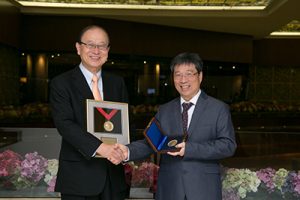
Tetsuya Osaka (left), recipient of the ECS Edward Goodrich Acheson Award, with ECS President Yue Kuo (right).
The ECS Edward Goodrich Acheson Award was presented to past ECS president Tetsuya Osaka, who serves as senior research professor and emeritus director of the Institute for Research Organization for Nano & Life Innovation, and as professor emeritus of the faculty of science and engineering at Waseda University in Tokyo, Japan. The award recognizes distinguished contributions to the advancement of the objects, purposes, and activities of ECS.
Osaka has also served as president of the Magnetics Society of Japan, president of the Electrochemical Society of Japan, and president of the Japan Institute of Electronic Packaging. He has made significant contributions to the advancement of electrochemical science and technology, particularly in the areas of electrodeposition, magnetic device fabrication, energy conversion, biosensors, and electrochemical nanotechnology.
The ECS Charles W. Tobias Young Investigator Award was presented to Michael Arnold for his work “Overcoming the Materials Science Challenges to Nanocarbon Electronics.” The award recognizes outstanding scientific or engineering work in fundamental or applied electrochemistry or solid state science and technology.
Arnold, a professor in the Materials Science and Engineering Department at the University of Wisconsin-Madison, says his focus is on two applications—first, to make new semiconductors that are better than silicon to make computer chips faster and use less power, so the battery lasts longer, and second, to create biosensors that can measure concentrations of proteins in blood by using a semiconductor.
“I’m trying to make new semiconductors from carbon that could improve all of those applications,” said Arnold.
In reference to the award, he said, “It’s fantastic recognition, not only just of my efforts but my students’ efforts. I mean, the students are the ones in my group doing the work, so it makes me proud to receive the reward, but it’s really pride in my group.”
The ECS Norman Hackerman Young Author Award was presented to Raymond Smith for his paper “Multiphase Porous Electrode Theory,” published in the Journal of The Electrochemical Society (JES). The award recognizes the best paper published by young authors in JES in the previous year.
Smith, who holds a PhD in chemical engineering from MIT and works as a senior engineer at Tesla, said he was blown away when he heard he was nominated for the award. His paper focuses on battery modeling—understanding exactly what is going on inside of a cell or a battery to improve the design and make it more effective.
His paper aimed to unify work that his team and other teams have done in the field in order to highlight connections that weren’t obvious before.
“I hope it provides a useful resource that maybe shows similarities between works, that maybe people weren’t aware were there before,” said Smith.
The ECS Bruce Deal & Andy Grove Young Author Award was presented to Shihyun Ahn for his paper “Temperature-Dependent Characteristics of Ni/Au and Pt/Au Schottky Diodes on β-Ga2O3” published in the ECS Journal of Solid State Science and Technology (JSS). The award, named for two pioneers in the semiconductor industry, recognizes the best paper published by young authors in JSS in the previous year.
Ahn, who holds a PhD in chemical engineering from the University of Florida, is currently working in the Ultraviolet Product Development Department at Seoul Viosys in Korea.
In May, ECS teamed up with Amazon to create Amazon Catalyst at ECS. The goal of the program is to find solutions that make life easier, healthier, more sustainable, and more enjoyable. To encourage and support researchers, Amazon Catalyst committed up to $100,000 to help fund the selected proposals. The awarded recipients are listed below.
- Sampath Kommandur and Aravindh Rajan ($1,600) | “Active Control of Heat Flor in Quantum Computing Applications through Piezoelectric Induced Mechanical Strain”
- Mohammadreza Nazemi ($25,000) | “Using Nanotechnology for Electrosynthesis of Nitrogen-Based Fertilizer under Ambient Conditions”
- Rajib Das ($25,000) | “Carbon Catalysts for Cost-Efficient Hydrogen Production in PEM Electolyzers”
- Jennifer Schaefer and Peng He ($36,000) | “Magnesium-Polysulfied Flow Batteries”
A progress report on each of these projects will be presented next year at the 236th ECS Meeting in Atlanta, GA.
The ECS Toyota Young Investigator Fellowship was awarded to two individuals: Kimberly See, from the California Institute of Technology, and Iryna Zenyuk, from the University of California, Irvine. Each will receive $50,000 to pursue projects in green energy technology.
Christina Bock, senior vice president of ECS, assisted with the introduction of the 2018 Class of Fellows. The 14 members are recognized for their contributions to the advancement and leadership in electrochemical and solid state science and technology, and for active participation in the affairs of ECS.
- Sheikh A. Akbar—for sustained high-quality contributions to the field of high-temperature sensors, education, and training of students, and for active participation in leadership activities in the field of sensors.
- Yi Cui—for outstanding contribution to nanotechnology and electrochemistry, particularly in energy storage.
- Jan Fransaer—for demonstrating world-class and high-quality scientific leadership in electrochemistry (fundamental and applied).
- Turgut M. Gür—for pioneering contributions to the development of carbon fuel cells for clean energy from fossil fuels and spontaneous hydrogen co-production, high-temperature electrocatalysis and electrosynthesis of industrially important reactions, surface and interface engineered thin film solid oxide fuel cells, and solid state ionic tools for fundamental materials research.
- Pawel J. Kulesza—for longstanding contributions and development of original approaches to fabrication, fundamental understanding, and utilization of highly functionalized and active electrochemical interfaces.
- Stuart Licht—for innovative work in energy storage, solar energy capture, and the development of a novel, sustainable means of producing commercial materials without greenhouse gas production.
- Y. Shirley Meng—for impactful contributions to battery research and the leadership and mentoring of students and young researchers.
- Junichiro Mizusaki—for extensive seminal contributions to the fundamental understanding of the reactions and the thermodynamic and electrochemical properties of materials in electrochemical devices and worldwide activities in the field of electrochemistry and solid state ionics.
- Venkat R. Subramanian—for outstanding contributions to the computational science and engineering that underpins safe and economical battery design and control.
- Jay Switzer—for pioneering and sustained contributions to the electrodeposition of ceramic films and epitaxial nanostructures and the relentless promotion of electrochemistry to the scientific community.
- Tomás Torres—for contributions toward the understanding of the chemistry of phthalocyanine-carbon nanostructures conjugates.
- Hiroyuki Uchida—for outstanding contributions in the areas of SOFC materials development, electrocatalysis, catalyst synthesis and characterization for low-temperature fuel cells and electrolyzers, and the design of electrodes for fuel cells and electrolyzers, as well as his fundamental studies on electrode reactions and degradation mechanisms.
- Sannakaisa Virtanen—for exceptional contributions to the field of corrosion, particularly in the areas of protective passive films and biocorrosion, and for sustained leadership in the field.
- Adam Z. Weber—for contributions to the understanding of transport phenomena in fuel cells and related electrochemical devices.
The ECS Outstanding Student Chapter Award was presented to the ECS University of Washington Student Chapter. The ECS Chapter of Excellence Awards were presented to the ECS Lewis University Student Chapter and the ECS University of Virginia Student Chapter.
There were 16 division and section awards presented over the course of the meeting.
- The ECS Battery Division Research Award was presented to Kang Xu of the U.S. Army Research Laboratory.
- The ECS Battery Division Technology Award was presented to Feng Pan of Peking University.
- The ECS Battery Division Technology Award was presented to Yongyao Xia of Fudan University.
- The ECS Battery Division Postdoctoral Associate Research Award sponsored by MTI Corporation and the Jiang Family Foundation was presented to Haodong Liu of the University of California, San Diego.
- The ECS Battery Division Postdoctoral Associate Research Award sponsored by MTI Corporation and the Jiang Family Foundation was presented to David Bock of Brookhaven National Laboratory.
- The ECS Battery Division Student Research Award sponsored by Mercedes-Benz Research & Development was presented to Fudong Han of the University of Maryland, College Park.
- The ECS Battery Division Student Research Award sponsored by Mercedes-Benz Research & Development was presented to Steven Lacey of the University of Maryland.
- The ECS Corrosion Division H. H. Uhlig Award was presented to Rudolph G. Buchheit of the University of Kentucky.
- The ECS Corrosion Division Morris Cohen Graduate Student Award was presented to Rebecca Schaller of the University of British Columbia.
- The ECS Electrodeposition Division Research Award was presented to Nosang Vincent Myung of the University of California, Riverside.
- The ECS Electrodeposition Division Early Career Investigator Award was presented to Jon Ustarroz of the Vrije Universiteit Brussel.
- The ECS High-Temperature Energy, Materials, & Processes Division Outstanding Achievement Award was presented to Meilin Liu of the Georgia Institute of Technology.
- The ECS Luminescence and Display Materials Division Centennial Outstanding Achievement Award was presented to Pieter Dorenbos of the Technical University of Delft.
- The ECS Physical and Analytical Electrochemistry Division Max Bredig Award in Molten Salt and Ionic Liquid Chemistry was presented to Robin D. Rogers of The University of Alabama.
- The ECS Sensor Division Outstanding Achievement Award was presented to Joseph Wang of the University of California, San Diego.
- The ECS Europe Section Alessandro Volta Medal was presented to Wolfgang Schuhmann of Ruhr-Universität Bochum.
Z01 General Student Poster Session
There were more than 80 student posters submitted to the Z01 General Student Poster Session at AiMES 2018. The recipients of the best student poster awards for AiMES 2018 are listed below.
- Aranzazu Cermona Orbezo, The University of Manchester, “Flow-Electrode Capacitive Deionization (FCDI) Using Suspensions of 2D Materials as Electrodes”
- Ashwin Ramanujam, Ohio University, “Rapid Electrochemical Detection of Escherichia coli Using a Rotating Disc Electrode”
- Jeffrey Kowalski, Joint Center for Energy Storage Research, “Systematic Development of Positive Active Materials for Nonaqueous Redox Flow Batteries Using Phenothiazine as a Learning Platform”
- Garrett Huang, Georgia Institute of Technology, “Advanced Anion Conducting Multiblock Copolymer Membranes with Hydrocarbon Backbones”
- Ayano Ohama, Ochanomizu University, “Pre-Treatment Effects on Electrochemical Lithium Deposition/Dissolution Processes Studied by Electrochemical Quartz Crystal Microbalance”
- Hafis Pratama Rendra Graha, Tokyo Institute of Technology, “Development of Highly Conductive and Highly Durable All-Aromatic Anion Exchange Membranes by Using Thermally Convertible Precursor Polymer”
The student poster awards acknowledge the quality and thoroughness of the candidates’ work, the originality and independence of their contributions, the significance and timeliness of the research results, and the depth of understanding of research topics and their relationships to ECS fields of interest.
Shova Neupane, from the University of Hasselt in Belgium, was a poster submitter in attendance. She said she enjoyed presenting her poster, as it allowed her the opportunity to receive feedback and answer questions regarding her work “Initial Zinc Electrodeposition on Copper Studied by In-Situ AFM” in a more intimate setting. “I noticed people held back on questions and comments during my talk,” Neupane explained. “The poster session makes it easier to have a conversation.”
Raciel Jamies Lopez, from the Universidad Autónoma Metroplitana in Mexico, said he enjoyed the diversity the student poster session brings, “from international students to unique perspectives.”
The following individuals served as organizers of the session: Venkat R. Subramanian (University of Washington), Kalpathy B. Sundaram (University of Central Florida), Vimal Chaitanya (New Mexico State University), Alice H. Suroviec (Berry College), Pallavi Pharkya (Lam Research Corporation), and Ricardo Galvàn-Martìnez (Universidad Veracruzana).
The following individuals served as student poster judges: Krysti Knoche Gupta (University of Wisconsin Eau Claire), Lok-kum Tsui (University of New Mexico), David Rodriguez (Los Alamos National Laboratory), Eiji Tada (Tokyo Institute of Technology), Vito Di Noto (University of Padova), Brian Skinn (Faraday Technology, Inc.), Rod Borup (Los Alamos National Laboratory), Shrisudersan Jayaraman (Corning Inc.), Jeffrey Halpern (University of New Hampshire), Nikolay Dimitrov (Binghamton University), Eugeniusz Zych (Uniwersytet Wroclawski), and Bryan McCloskey (University of California, Berkeley).
ECS thanks the organizers and judges for making the session a success.
Cena Baile
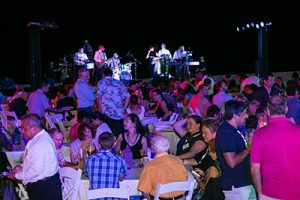
AiMES wrapped up with the Cena Baile, a reception that featured food, drinks, and live entertainment.
Featuring drinks, food, and good conversation, the Cena Baile wrapped up AiMES with a sendoff only fitting for Cancun—a brief torrential downpour. Of course, that didn’t stop the festivities, beforehand or after.
The night opened with live music and entertainment on the beachside Moonlight Terrace. Guests partook in the local cuisine while being invited to the dance floor. Although the event was cut short, attendees were able to enjoy an evening outdoors before heading off to other engagements.
Sponsors and Exhibitors
Special thanks to the meeting’s sponsors and exhibitors, whose support and participation directly contributed to the success of the meeting.
Thank you for developing the tools and equipment driving scientific advancement and for sharing your innovations with the ECS community.
Silver Level





